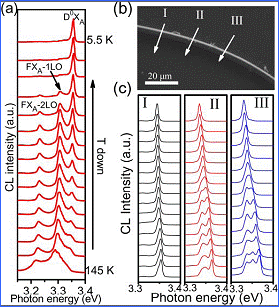Time:2012-12-04ClickTimes:
Strain engineering has long been an important route to tune the band structure and change properties of semiconductors. However, high local strain is accompanied by high strain-gradient in most situations, especially in flexible electronics and nanodevices. However, to our best knowledge, the intriguing effect of strain-gradient upon the energy bands of semiconductors remains completely unexplored, and how it influences the device optical and electronic performance remains a challenge to both the experimental and theoretical communities.
Recently, Professor Dapeng Yu’s group has conducted extensive investigation on the spatial distribution of exciton spectra in bent ZnO microwires by high resolution cathodoluminescence (CL) characterizations, revealing a significant non-local strain-gradient effect on the band structure of the bent microwires and beyond the well known strain effect. Bending induced blue-shift in the compressive region is nonlinear while the red-shift in the tensile and strain free region increases linearly with strain-gradient in addition to strain effect, destroying the symmetry of local strain effect shown in ZnO under uniform deformation and leading to overall redshift in the bent microwires. First principles modeling reveals some physics mechanisms for bending induced red-shift. This novel strain-gradient effect should pave an additional path to the energy band engineering of semiconductors.

|
Figure 1. This figure ilustrates the strain-gradient effect on the optical-electronic properties in a bent ZnO microwire, with a much stronger red-shift on the outer tensile side than a blue-shift on the inner compressive side. The low temperature cathodoluminescence cross-sectional scanning spectra on the strain-neutral middle-plane are highlighted by thicker black lines, which clearly shows a strain-gradient induced red-shift.
|
Moreover, Professor Yu’s group extended the study of the strain effect on ZnO near band emission down to liquid helium temperature. The group investigated for the first time the exciton spectra evolution in bent ZnO microwires along the radial direction via high spatial/energy resolution cathodeluminescence spectroscopy at 5.5K. The experiments show that the exciton peak splits into multi fine peaks towards the compressive part while retains one peak in the tensile part and the emission peak displays a continuous blue-shift from tensile to compressive edges. In combination with first-principles calculations, the observed NBE emission splitting is due to the valence band splitting and the absence of peak splitting in the tensile part maybe due to the highly localized holes in the A band and the carrier density distribution across the microwire. These studies may pave the way to design nanophotonic and electronic devices using bent ZnO nanowires.

|
Figure 2. Temperature dependent CL spectra of strain-free ZnO microwire and line scan CL spectra in bent ZnO microwires along the radial direction. (a) Temperature dependent CL spectra of strain-free ZnO microwire from 145K to 5.5K. (b) SEM image of a bent ZnO microwire for CL line scan. The white arrows indicate the positions and the line scan directions for CL measurements. (c) Line scan CL spectra obtained from positions indicated by white arrows in (b). From top to bottom the individual CL spectrums were obtained point by point along the radial directions across the bent ZnO microwire from tensile to compressive edges.
|
Related Publications:
Strain-Gradient Effect on Energy Bands in Bent ZnO Microwires, Xiaobing Han, Liangzhi Kou, Zhuhua Zhang, Ziyue Zhang, Xinli Zhu, Jun Xu, Zhimin Liao, Wanlin Guo, and Dapeng Yu , Advanced Materials 24, 4707 (2012).
Strain induced exciton fine-structure splitting and shift in bent ZnO microwires, Zhi-Min Liao, Han-Chun Wu, Qiang Fu, Xuewen Fu, Xinli Zhu, Jun Xu, Igor V. Shvets, Zhuhua Zhang, Wanlin Guo, Y. Leprince-Wang, Qing Zhao, Xiaosong Wu, Da-Peng Yu, Scientific Reports 2, 452 (2012).
